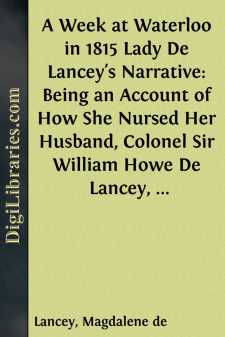Categories
- Antiques & Collectibles 13
- Architecture 36
- Art 48
- Bibles 22
- Biography & Autobiography 813
- Body, Mind & Spirit 142
- Business & Economics 28
- Children's Books 15
- Children's Fiction 12
- Computers 4
- Cooking 94
- Crafts & Hobbies 4
- Drama 346
- Education 46
- Family & Relationships 57
- Fiction 11828
- Games 19
- Gardening 17
- Health & Fitness 34
- History 1377
- House & Home 1
- Humor 147
- Juvenile Fiction 1873
- Juvenile Nonfiction 202
- Language Arts & Disciplines 88
- Law 16
- Literary Collections 686
- Literary Criticism 179
- Mathematics 13
- Medical 41
- Music 40
- Nature 179
- Non-Classifiable 1768
- Performing Arts 7
- Periodicals 1453
- Philosophy 64
- Photography 2
- Poetry 896
- Political Science 203
- Psychology 42
- Reference 154
- Religion 513
- Science 126
- Self-Help 84
- Social Science 81
- Sports & Recreation 34
- Study Aids 3
- Technology & Engineering 59
- Transportation 23
- Travel 463
- True Crime 29
A Week at Waterloo in 1815 Lady De Lancey's Narrative: Being an Account of How She Nursed Her Husband, Colonel Sir William Howe De Lancey, Quartermaster-General of the Army, Mortally Wounded in the Great Battle
Description:
Excerpt
INTRODUCTION
The following narrative, written over eighty years ago, and now at last given to the world in 1906, is remarkable in many respects.
It is remarkable for its subject, for its style, and for its literary history.
The subject—a deathbed scene—might seem at first sight to be a trite and common one. The mise-en-scène—the Field of Waterloo—alone however redeems it from such a charge; and the principal actors play their part in no common-place or unrelieved tragedy. "Certainly," as Bacon says, "Vertue is like pretious Odours, most fragrant when they are incensed or crushed: For Prosperity doth best discover Vice; But Adversity doth best discover Vertue."
As to the style, it will be sufficient to quote the authority of Dickens for the statement that no one but Defoe could have told the story in fiction.
Its literary history is even more remarkable than either its style or its subject.
It is no exaggeration to say of the narrative—as Bacon said of the Latin volume of his Essays—that it "may last as long as Bookes last." And yet it has remained in manuscript for more than eighty years. This is probably unique in the history of literature since the Invention of Printing.
As regards the hero of the narrative, the Duke of Wellington once said that he "was an excellent officer, and would have risen to great distinction had he lived."
Notes of Conversations with the Duke of Wellington, by Earl Stanhope, p. 183.
Captain Arthur Gore, who afterwards became Lieutenant-General Gore, alludes to him in the following terms: "This incomparable officer was deservedly esteemed by the Duke of Wellington, who honoured him with his particular confidence and regard."
Explanatory Notes on the Battle of Waterloo, by Captain Arthur Gore, 1817, p. 83.
His ancestors, for several generations, had been men of great distinction, and he undoubtedly inherited their great qualities in a very high degree.
The De Lancey family is one of Huguenot origin, the founder of the family, Etienne De Lancey, having fled from France at the time of the Revocation of the Edict of Nantes in 1685.
In French annals the family can be traced back to the time of the Hundred Years' War. The first of the name, of whom there is any authentic record, was Guy de Lancy, Vicomte de Laval et de Nouvion, who in 1432 held of the Prince Bishop of Laon and Nouvion, villages and territories a few miles south of that city. See History of New York during the Revolutionary War, by Thomas Jones, edited by Edward Floyd De Lancey, vol i., p. 651, and Dictionnaire de la Noblesse de France, vol. viii., title "Lancy."
The following extracts treating of the family history are taken from Appleton's Cyclopædia of American Biography.
The author of the articles, Edward Floyd De Lancey, was born in 1821, and died at Ossining, N.Y., on the 7th April 1905. At one time he held the position of President of the New York Genealogical Society, and has done a great deal of work in the field of historical research.
For biographical sketch, see Appleton's Cyclopædia, vol. ii., p. 130.
"Etienne De Lancey (great-grandfather of Sir William De Lancey), was born in Caen, France, 24th October 1663; and died in the city of New York, 18th November 1741. Having been compelled, as a Protestant, to leave France on the revocation of the Edict of Nantes (18th October 1685), he escaped into Holland. Deciding to become a British subject and to emigrate to America, he crossed to England and took the oath of allegiance to James II. He landed in New York, 7th June 1686. His mother had given him, on his departure from Caen, a portion of the family jewels. He sold them for £300, became a merchant, and amassed a fortune of £100,000. He married Anne, second daughter of Stephanus van Cortlandt, 23rd January 1700....


